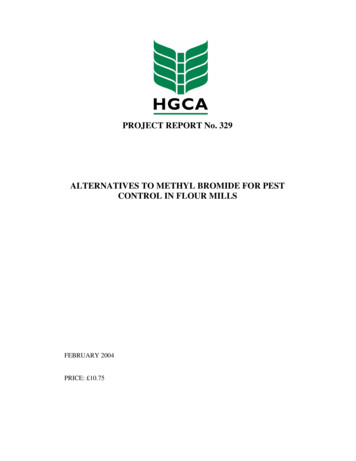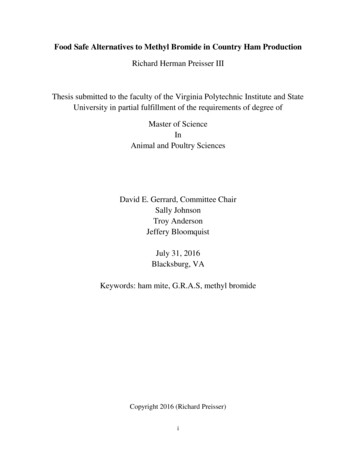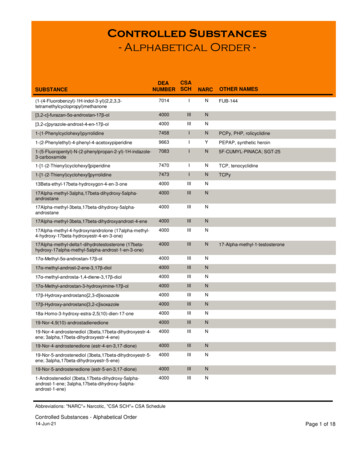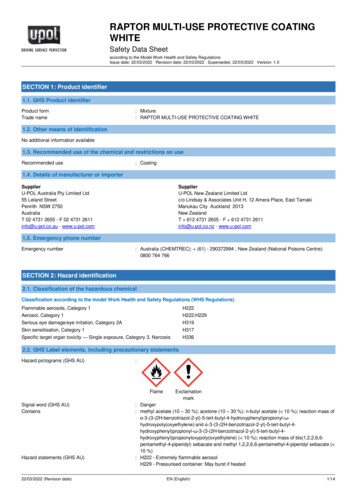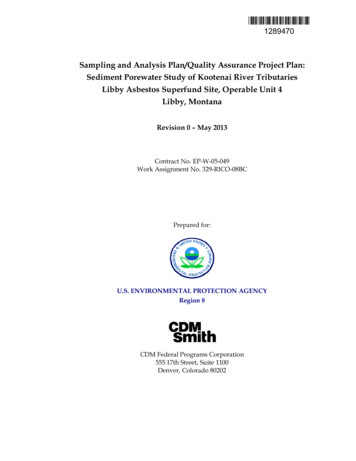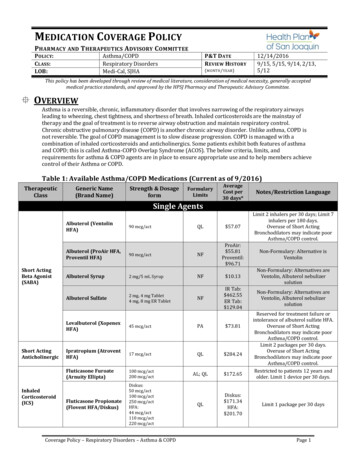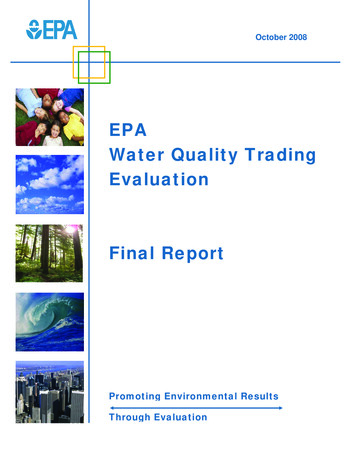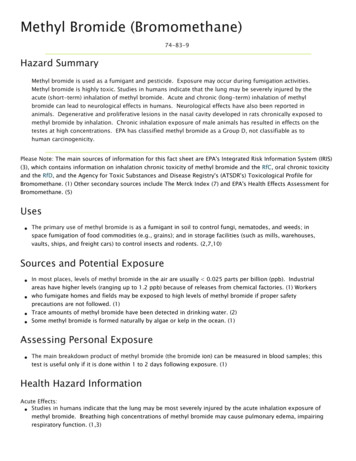
Transcription
Methyl Bromide (Bromomethane)74-83-9Hazard SummaryMethyl bromide is used as a fumigant and pesticide. Exposure may occur during fumigation activities.Methyl bromide is highly toxic. Studies in humans indicate that the lung may be severely injured by theacute (short-term) inhalation of methyl bromide. Acute and chronic (long-term) inhalation of methylbromide can lead to neurological effects in humans. Neurological effects have also been reported inanimals. Degenerative and proliferative lesions in the nasal cavity developed in rats chronically exposed tomethyl bromide by inhalation. Chronic inhalation exposure of male animals has resulted in effects on thetestes at high concentrations. EPA has classified methyl bromide as a Group D, not classifiable as tohuman carcinogenicity.Please Note: The main sources of information for this fact sheet are EPA's Integrated Risk Information System (IRIS)(3), which contains information on inhalation chronic toxicity of methyl bromide and the RfC, oral chronic toxicityand the RfD, and the Agency for Toxic Substances and Disease Registry's (ATSDR's) Toxicological Profile forBromomethane. (1) Other secondary sources include The Merck Index (7) and EPA's Health Effects Assessment forBromomethane. (5)UsesThe primary use of methyl bromide is as a fumigant in soil to control fungi, nematodes, and weeds; inspace fumigation of food commodities (e.g., grains); and in storage facilities (such as mills, warehouses,vaults, ships, and freight cars) to control insects and rodents. (2,7,10)Sources and Potential ExposureIn most places, levels of methyl bromide in the air are usually 0.025 parts per billion (ppb). Industrialareas have higher levels (ranging up to 1.2 ppb) because of releases from chemical factories. (1) Workerswho fumigate homes and fields may be exposed to high levels of methyl bromide if proper safetyprecautions are not followed. (1)Trace amounts of methyl bromide have been detected in drinking water. (2)Some methyl bromide is formed naturally by algae or kelp in the ocean. (1)Assessing Personal ExposureThe main breakdown product of methyl bromide (the bromide ion) can be measured in blood samples; thistest is useful only if it is done within 1 to 2 days following exposure. (1)Health Hazard InformationAcute Effects:Studies in humans indicate that the lung may be most severely injured by the acute inhalation exposure ofmethyl bromide. Breathing high concentrations of methyl bromide may cause pulmonary edema, impairingrespiratory function. (1,3)Acute exposure by inhalation of methyl bromide frequently leads to neurological effects in humans.
Acute exposure by inhalation of methyl bromide frequently leads to neurological effects in humans.Symptoms of acute exposure in humans include headaches, dizziness, fainting, apathy, weakness,confusion, speech impairment, visual effects, numbness, twitching, and tremors; in severe cases paralysisand convulsions are possible. Acute exposure may produce delayed effects. Symptoms may improvewithout treatment in less serious cases. (1,3)Methyl bromide is irritating to the eyes, skin, and mucous membranes of the upper respiratory tract.Dermal exposure to methyl bromide can cause itching, redness, and blisters in humans. (1)Kidney damage has been observed in humans who have inhaled high levels of methyl bromide. (1)Inhalation of methyl bromide may cause the liver to become swollen and tender, but no significant injury tothe liver has been observed in humans. (1)Injury to the heart has been observed in mice and rats exposed to high concentrations of methyl bromideby inhalation. (1,3)Tests involving acute exposure of rats and mice have demonstrated methyl bromide to have high acutetoxicity from inhalation and oral exposure. (4)Chronic Effects (Noncancer):Data from an occupational study suggest that mild functional neurological impairment may result inhumans chronically exposed to methyl bromide by inhalation exposure, but this is not conclusive due toconcurrent exposure to other chemicals and inadequate quantitation of exposure levels and durations.(1,3,5)Neurological effects, including lethargy, forelimb twitching, tremors, and paralysis, have also been observedin animal studies. (3,6)Degenerative and proliferative lesions in the nasal cavity developed in rats chronically exposed to methylbromide by inhalation. (3)3The Reference Concentration (RfC) for methyl bromide is 0.005 milligrams per cubic meter (mg/m ) basedon degenerative and proliferative lesions of the olfactory epithelium of the nasal cavity. The RfC is anestimate (with uncertainty spanning perhaps an order of magnitude) of a continuous inhalation exposure tothe human population (including sensitive subgroups) that is likely to be without appreciable risk ofdeleterious noncancer effects during a lifetime. It is not a direct estimator of risk but rather a referencepoint to gauge the potential effects. At exposures increasingly greater than the RfC, the potential foradverse health effects increases. Lifetime exposure above the RfC does not imply that an adverse healtheffect would necessarily occur. (3)EPA has medium confidence in the study on which the RfC was based because even though the study waswell conducted, it did not identify a no-observed-adverse-effect level (NOAEL); high confidence in thedatabase because there is a chronic inhalation study in two species supported by subchronic inhalationstudies in several species and because data are available on the developmental and reproductive effects ofbromomethane as well as its pharmacokinetics following inhalation exposure; and, consequently, highconfidence in the RfC. (3)The Reference Dose (RfD) for methyl bromide is 0.0014 milligrams per kilogram body weight per day(mg/kg/d) based on epithelial hyperplasia of the forestomach in rats. (3)EPA has medium confidence in the study on which the RfD was based because it used the preferred route ofadministration for derivation of an oral RfD, the study was adequately conducted, and the determination ofepithelial hyperplasia of the forestomach was independently confirmed; medium confidence in the database;and, consequently, medium confidence in the RfD. (3)Reproductive/Developmental Effects:No information is available on the reproductive or developmental effects of methyl bromide in humans.Information from animal studies suggest that methyl bromide does not cause birth defects and does notinterfere with normal reproduction except at high exposure levels. (1)Chronic inhalation exposure of male animals has resulted in effects on the testes at high concentrations.(1,3)Inhalation exposure of animals during gestation has not resulted in significant developmental effects, even
Inhalation exposure of animals during gestation has not resulted in significant developmental effects, evenwhen there was severe maternal toxicity. (1,3,5)Cancer Risk:In a human mortality study, a higher incidence of death from testicular cancer was identified in menoccupationally exposed to methyl bromide. However, methyl bromide could not be established as thecausative agent because the individuals in the study were exposed to a wide variety of brominatedchemicals. (1,3,5)There was no evidence of carcinogenic activity in mice in a National Toxicology Program (NTP) chronicinhalation study. (6)EPA has classified methyl bromide as a Group D, not classifiable as to human carcinogenicity, based oninadequate human and animal data. (3,5)Physical PropertiesThe chemical formula for methyl bromide is CH Br, and it has a molecular weight of 94.95 g/mol. (7)3Methyl bromide occurs as a colorless and highly volatile gas that is slightly soluble in water. (7,8)Methyl bromide is practically o dorless but has a sweetish chloroform-like odor at high concentrations3with an odor threshold of 80 mg/m . (3,7,9)The vapor pressure for methyl bromide is 1,420 mm Hg at 20 C, and it has a log octanol/water partitioncoefficient (log K ) of 1.1. (1)owConversion Factors:33To convert concentrations in air (at 25 C) from ppm to mg/m : mg/m (ppm) (molecular weight of the3compound)/(24.45). For methyl bromide: 1 ppm 3.9 mg/m .Health Data from Inhalation Exposure
AIHA ERPG--American Industrial Hygiene Association's emergency response planning guidelines. ERPG 2 is themaximum airborne concentration below which it is believed nearly all individuals could be exposed up to one hourwithout experiencing or developing irreversible or other serious health effects that could impair their abilities totake protective action.ACGIH TLV--American Conference of Governmental and Industrial Hygienists' threshold limit value expressed as atime-weighted average; the concentration of a substance to which most workers can be exposed without adverseeffect.LC (Lethal Concentration )--A calculated concentration of a chemical in air to which exposure for a specific5050length of time is expected to cause death in 50% of a defined experimental animal population.LOAEL--Lowest-observed-adverse-effect level.OSHA PEL--Occupational Safety and Health Administration's permissible exposure limit expressed as a timeweighted average; the concentration of a substance to which most workers can be exposed without adverse effectaveraged over a normal 8-h workday or a 40-h workweek.The health and regulatory values cited in this factsheet were obtained in December 1999.abHealth numbers are toxicological numbers from animal testing or risk assessment values developed by EPA.Regulatory numbers are values that have been incorporated in Government regulations, while advisory numbersare nonregulatory values provided by the Government or other groups as advice. OSHA numbers are regulatory,whereas ACGIH and AIHA numbers are advisory.cThis LOAEL is from the critical study used as the basis for the EPA RfC.References
ReferencesSummary created in April 1992, updated January 20001. Agency for Toxic Substances and Disease Registry (ATSDR). Toxicological Profile for Bromomethane. U.S.Public Health Service, U.S. Department of Health and Human Services, Atlanta, GA. 1992.2. U.S. Environmental Protection Agency. Bromomethane Health Advisory. Office of Drinking Water,Washington, DC. 1989.3. U.S. Environmental Protection Agency. Integrated Risk Information System (IRIS) on Bromomethane.National Center for Environmental Assessment, Office of Research and Development, Washington, DC.1999.4. U.S. Department of Health and Human Services. Registry of Toxic Effects of Chemical Substances (RTECS,online database). National Toxicology Information Program, National Library of Medicine, Bethesda, MD.1993.5. U.S. Environmental Protection Agency. Health Effects Assessment for Bromomethane. EPA/600/8-88/022.Environmental Criteria and Assessment Office, Office of Health and Environmental Assessment, Office ofResearch and Development, Cincinnati, OH. 1988.6. National Toxicology Program. Toxicology and Carcinogenesis Studies of Methyl Bromide (CAS No. 74-839) in B6C3F1 Mice (Inhalation Studies). Technical Report No. TR-385. 1992.7. The Merck Index. An Encyclopedia of Chemicals, Drugs, and Biologicals. 11th ed. Ed. S. Budavari. Merck andCo. Inc., Rahway, NJ. 1989.8. International Agency for Research on Cancer (IARC). IARC Monographs on the Evaluation of theCarcinogenic Risk of Chemicals to Humans: Some Halogenated Hydrocarbons and Pesticide Exposures.Volume 41. World Health Organization, Lyon. 1986.9. U.S. Department of Health and Human Services. Hazardous Substances Data Bank (HSDB, online database).National Toxicology Information Program, National Library of Medicine, Bethesda, MD. 1993.10. M. Sittig. Handbook of Toxic and Hazardous Chemicals and Carcinogens. 2nd ed. Noyes Publications, ParkRidge, NJ. 1985.11. American Industrial Hygiene Association (AIHA). The AIHA 1998 Emergency Response Planning Guidelinesand Workplace Environmental Exposure Level Guides Handbook. 1998.12. Occupational Safety and Health Administration (OSHA). Occupational Safety and Health Standards, Toxicand Hazardous Substances. Code of Federal Regulations 29 CFR 1910.1000. 1998.13. American Conference of Governmental Industrial Hygienists (ACGIH). 1999 TLVs and BEIs. Threshold LimitValues for Chemical Substances and Physical Agents. Biological Exposure Indices. Cincinnati, OH. 1999.
without treatment in less serious cases. (1,3) Methyl bromide is irritating to the eyes, skin, and mucous membranes of the upper respiratory tract. Dermal exposure to methyl bromide can cause itching, redness, and blisters in humans. (1) Kidney damage has been observed in humans who have inhaled high levels of methyl bromide. (1)
